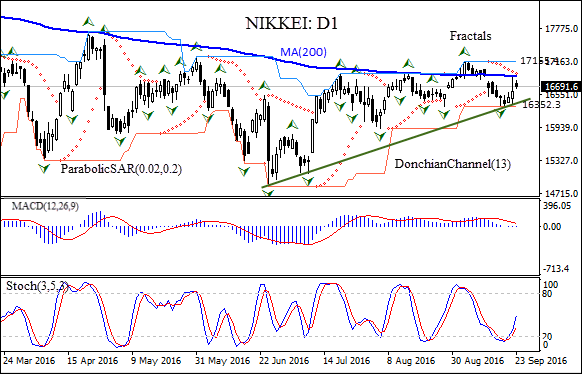Bank of Japan monetary stimulus program extension may lift Nikkei
The Bank of Japan left the deposit rate at minus 0.1% at September 21 policy meeting but stated it will continue quantitative easing program until the inflation overshoots the 2% inflation target. Will Nikkei continue rising?
The Japanese GDP expanded 0.2% in the second quarter over the previous quarter, slowing from 0.5% quarterly rate in the first quarter. The government unveiled a new budget with expanded fiscal spending measures of JPY 28.1 trillion ($269 billion) to stimulate the economy in addition to existing monetary program of quantitative easing. The focus of the adopted spending measures was the reconstruction in earthquake-hit areas and infrastructure projects. Data show the economy expanded in the second quarter as fixed capital investment increased, with private consumption and contribution from external trade steady. Recent reports indicate continued growth in following months too: capital spending expanded in July with core machinery orders ring 4.9% over the previous month, following a 8.3% growth in June. While industrial production was flat in July after a 2.3% increase in June, another positive development was improvement in consumer confidence with consumer sentiment rising in August to 42.0 from 41.3 in July. For export oriented Japanese economy with stagnant domestic demand the pace of economic growth depends strongly on external demand. And despite a massive quantitative easing program Japanese yen is rising, negatively impacting competitiveness of Japanese exporters and limiting growth. At the same time the Bank of Japan left the deposit rate at minus 0.1% at September 21 policy meeting but stated it will continue asset purchases of quantitative easing program until the inflation overshoots the 2% inflation target. While the size of annual asset purchases was not increased the extension of asset purchases will provide continued increase in liquidity which is bullish for growth and asset prices.

On the daily chart the NIKKEI: D1 has been rising since end of June. The price is edging toward the 200-day moving average.
The Donchian channel indicates no trend yet: the channel is flat.
The Parabolic indicator gives a sell signal.
The MACD indicator is below the signal line and the gap is narrowing, which is a bullish signal.
The stochastic oscillator is rising and hasn’t reached the overbought zone.
We believe the bullish momentum will continue after the price closes above the fractal high at 17155.4. A pending order to buy can be placed above that level. The stop loss can be placed below the last fractal low at 16352.3. After placing the pending order the stop loss is to be moved every day to the next fractal low, following Parabolic signals. Thus, we are changing the probable profit/loss ratio to the breakeven point. More conservative traders can switch to the 4-hour chart and move the stop-loss in the direction of the trade. If the price meets the stop loss level(16352.3) without reaching the order(17155.4), we recommend cancelling the position: the market sustains internal changes which were not considered.
Technical Analysis Summary
Position Buy
Buy stop Above 17155.4
Stop loss Below 16352.3
This overview has an informative character and is not financial advice or a recommendation. IFCMarkets. Corp. under any circumstances is not liable for any action taken by someone else after reading this article.
Recommended Content
Editors’ Picks
EUR/USD edges lower toward 1.0700 post-US PCE

EUR/USD stays under modest bearish pressure but manages to hold above 1.0700 in the American session on Friday. The US Dollar (USD) gathers strength against its rivals after the stronger-than-forecast PCE inflation data, not allowing the pair to gain traction.
GBP/USD retreats to 1.2500 on renewed USD strength

GBP/USD lost its traction and turned negative on the day near 1.2500. Following the stronger-than-expected PCE inflation readings from the US, the USD stays resilient and makes it difficult for the pair to gather recovery momentum.
Gold struggles to hold above $2,350 following US inflation

Gold turned south and declined toward $2,340, erasing a large portion of its daily gains, as the USD benefited from PCE inflation data. The benchmark 10-year US yield, however, stays in negative territory and helps XAU/USD limit its losses.
Bitcoin Weekly Forecast: BTC’s next breakout could propel it to $80,000 Premium

Bitcoin’s recent price consolidation could be nearing its end as technical indicators and on-chain metrics suggest a potential upward breakout. However, this move would not be straightforward and could punish impatient investors.
Week ahead – Hawkish risk as Fed and NFP on tap, Eurozone data eyed too

Fed meets on Wednesday as US inflation stays elevated. Will Friday’s jobs report bring relief or more angst for the markets? Eurozone flash GDP and CPI numbers in focus for the Euro.